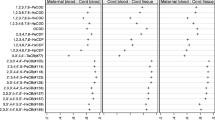Abstract
A review of the literature was conducted to investigate the importance to offspring of in utero and breast milk polychlorinated biphenyl (PCB) exposure. All reports that we could identify (n=25) were included, representing 16 study populations. Tissue-specific PCB concentrations in human placenta, breast milk, maternal blood and cord blood were compared to determine accumulation ratios between tissue compartments. On a lipid basis, the highest concentration of PCB in placenta (5027 ng/g fat) was 2.8 times higher than the highest concentration of PCB in breast milk (1770 ng/g fat). While there are limitations with regard to quantitation methods and statistical methods utilized by the reviewed studies, our results suggest that PCBs may be capable of crossing the placenta to a greater extent than previously believed. Future studies of PCB body burden in the perinatal period should include placenta, breast milk, maternal and cord blood specimens. In order to compare PCB concentrations in various tissues and with other studies, concentrations should be determined on a lipid basis.
Similar content being viewed by others
Author information
Authors and Affiliations
Corresponding author
Rights and permissions
About this article
Cite this article
DEKONING, E., KARMAUS, W. PCB exposure in utero and via breast milk. A review. J Expo Sci Environ Epidemiol 10, 285–293 (2000). https://doi.org/10.1038/sj.jea.7500090
Received:
Accepted:
Published:
Issue Date:
DOI: https://doi.org/10.1038/sj.jea.7500090
- Springer Nature America, Inc.
Keywords
This article is cited by
-
Flame Retardants and Neurodevelopment: an Updated Review of Epidemiological Literature
Current Epidemiology Reports (2020)
-
Using Spectrometric Colour Measurement for the Prediction of Soil PCBs in a Contaminated Site of Southern Italy
Water, Air, & Soil Pollution (2019)
-
Exposure to organochlorine pesticides is an independent risk factor of hepatocellular carcinoma: A case–control study
Journal of Exposure Science & Environmental Epidemiology (2012)
-
Exposure to organochlorine pesticides is independent risk factor of hepatocellular carcinoma: A case–control study
Journal of Exposure Science & Environmental Epidemiology (2011)
-
Effect of placental function on fatty acid requirements during pregnancy
European Journal of Clinical Nutrition (2004)




